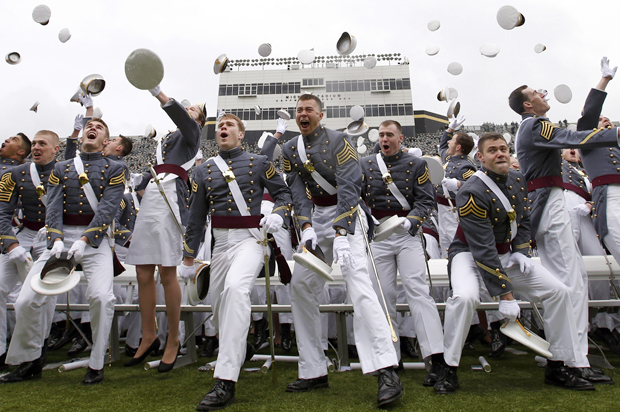The college only accepts 10% of its applicants, which makes sense given its challenging curriculum. Not only are students expected to learn new material, they have to learn how to be a cadet in the military. Their structured day to day lives include working out for multiple hours, learning a variety of military drills (one of the drills involved students entering a room filled with tear gas. They were forced to open their eyes and mouths as wide as they could, and when they got out they started coughing and sobbing), cleaning for SAMIs (Saturday Morning Inspections. Prepping for a SAMI can take longer than 7 hours). They also are expected to memorize phrases from a booklet called the West Point Guide (see a list of phrases: http://www.west-point.org/academy/malo-wa/inspirations/buglenotes.html )

The plebes (or Freshmen) may be asked a phrase from the guide at any moment by upperclassmen. If the Plebe doesn't know a phrase verbatim, he or she is subject to hazing.
You are probably wondering what any of this has to do with history, but as it turns out, Westpoint has trained some of the greatest leaders in history: Robert E. Lee, General Patton, Douglas MacArthur, and Edgar Allen Poe (Poe dropped out.) Even presidents like Grant and Eisenhower went to Westpoint.
Even more impressive, the Academy was actually founded by George Washington and Thomas Jefferson in 1802--right after the Revolutionary War! It wasn't easy, given that many of the founding fathers were dubious about starting a military academy. Some members of congress saw it as too aristocratic and voted against it.
It wasn't until 1817 that the Academy became more of an academy and less of a military bootcamp. Superintendent Col. Sylvanus Thayer put a new emphasis on honor, improved the academics, and created the "Thayer Method." The method includes small class sizes and time for individual studying. Thayer introduced the songs and sayings that formed West Point's culture, making it very attractive to ambitious students.

Their game was called 'The Silencing," a reflection of the racial prejudices that were present even after the Emancipation Proclamation.

Before the Clinton era, there were no gay students allowed at West Point. In the Clinton Era, cadets had to follow the "Don't Ask, Don't Tell" policy of the Clinton era, which meant that they could attend the academy as long as they didn't come out as gay. Obama repealed DADT in 2011, making the academy a more inclusive place. Today, there exists a gay-straight alliance known as Spectrum at the college.


Sources:
http://www.usma.edu/wphistory/SitePages/Notable%20Graduates.aspx
http://penelope.uchicago.edu/Thayer/E/Journals/Military_Affairs/24/4/The_Forgotten_Founder_of_West_Point*.html
http://www.usma.edu/SitePages/Home.aspx
https://www.nytimes.com/topic/organization/united-states-military-academy
http://www.buffalosoldier.net/HenryO.Flipper2.htm
I learned so much about the history of West Point from this post. I found that the school has reflected many of the social changes throughout history, from the civil rights movement to the gay movement. It shows us how changes in schools usually exemplify the social reforms of the time, for example, the inclusion of women's sports, desegregation of black and white children, were all part of larger social changes.
ReplyDelete